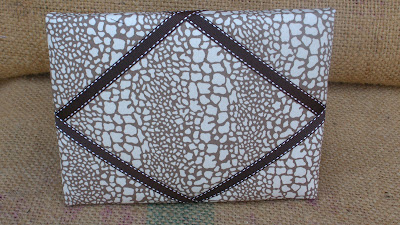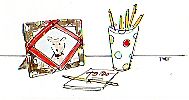






















You create modern, witty needlepoint art (a phrase many, who haven’t seen your work, may consider an oxymoron.) What drew you to this medium? I particularly love your piece “Perky Boobies;” do you think that we are returning to an appreciation of the “home arts” like entertaining, embroidery and gardening?
Oh, Sariah, I hope so. I think this recession has forced us all to turn inward and to realize that the It bag we all had to have five years ago is a hollow substitute for the pleasures of a meaningful life. In the last year, I have been much more conscious of living large on a small scale. Friends come over, we cook, we entertain, we talk, we laugh and we have a deep appreciation for each other’s company.
In terms of my textile work, my embroideries and postmodern samplers are a compulsion; I can’t not create them. My mother and grandmother both embroidered, and I grew up watching them, but they always worked from kits and that never appealed to me. When I saw the Bayeux Tapestry, I had a sudden epiphany that I needed to embroider MY life and my words instead of someone else’s. And that’s what I’ve done.

 Working, working, working after my winter hibernation, trying to get ready for my next boutique in Richmond, Virginia. My terrific monogrammer just embroidered 40 ribbons to get me ready for the spring graduation season. More photos after I finish a weekend of work in the studio. Can't wait to show you the 2011 spring line.
Working, working, working after my winter hibernation, trying to get ready for my next boutique in Richmond, Virginia. My terrific monogrammer just embroidered 40 ribbons to get me ready for the spring graduation season. More photos after I finish a weekend of work in the studio. Can't wait to show you the 2011 spring line.




While Hamburger and Galison focused on the rare and the remarkable in Harvard’s collections, Laurel Thatcher Ulrich, the 300th Anniversary University Professor, and Ivan Gaskell, Margaret S. Winthrop Curator in theHarvard Art Museums and senior lecturer on history, extolled the virtues of the mundane and the everyday: a toothbrush, a chair, a piece of clothing. “My adventure has been to move into the realm of material objects and use them to study ordinary people in ordinary life,” Ulrich said.
Ulrich, the developer of the popular General Education course and exhibition “Tangible Things,” stood at the front of the classroom and pulled a quilt out of an old bookcase. The quilt, which was made in Missouri during the 1920s, was designed with dark blue hexagons. She said that she had students research the source of the design, which led them back hundreds of years to a study of Islamic decorative art, its migration through Europe and then to America. An examination of the cloth and its manufacture in the American South took students through the history of slavery.
Ulrich said that she wanted her students to work with artifacts to “break them out of their narrowness” and help them make connections between unrelated things like a quilt made in Missouri and an Islamic tile.
Observation is such an important part of learning. Connections: one era to an another. Everything repeats. We are inspired by the past. Read and See. See and Do. Listen. Start each day with the idea of learning something new. When I am in a funk and nothing seems to be working out I remember my mantra: make each day matter. What I mean by this is to use my senses to keenly observe the world around me. I am pleasantly surprised by something I discover. Small joys. All for free. Just open your eyes, your ears, your heart and you too will be amazed by a little nugget of wisdom or joy.
“You see cultural contact and exchange in ways that you cannot see in books and writing,” she said. “Students get really excited when you put them in touch with real stuff.”

























